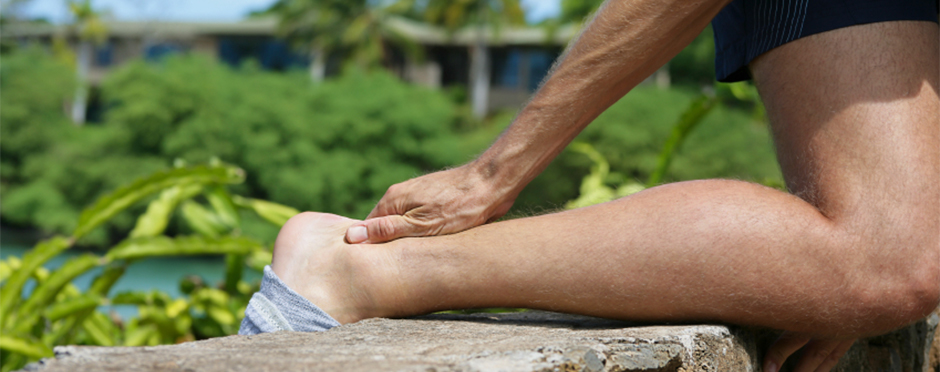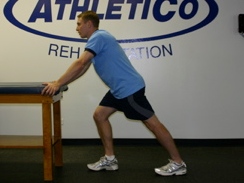
Active Lifestyles and Achilles Tendinitis
2 CommentsHave you ever experienced pain or swelling in your Achilles heel after prolonged activity? Though the Achilles is the strongest tendon in the body, it’s still susceptible to injury. Achilles tendinitis is an overuse injury of the Achilles tendon, which is the tendon that connects the calf muscles at the back of your lower leg to your heel bone. It is a common condition in endurance athletes and other athletes who put repetitive stress on their feet and Achilles tendon. Here are some of the common causes, symptoms, and ways to manage the pain.
Causes
Achilles tendinitis is a chronic condition which results from repetitive or intense strain on the
tendon. As people age, tendons become less flexible and therefore more susceptible to injury. Middle-aged recreational athletes are the most susceptible to this injury. Common causes can include:
- Tight calf musculature. Stretching is an important step in preventing and avoiding this type of injury.
- Overpronation. This is when your foot rolls excessively inward when it should be pushing off. If you look at the bottom of your shoe and you see a lot of wear on the inner sides of your shoes you could be a pronator. Overpronation causes extra stress and tightness to the muscles in the area.
- Recent changes in footwear and/or changes in training schedules. Often distance runners will have symptoms after increasing their mileage or increasing hill training.
- Other underlying problem such as bone spurs. A bone spur is an extra bone that grows in the heel where the Achilles tendon attaches. The bone spur creates friction against the tendon and pain.
Symptoms
The main complaint with this type of injury is pain behind the heel of the affected tendon. Most prominently, the pain is located about 2-4 centimeters above where the tendon connects to the heel bone. Other symptoms may include:
- Pain/stiffness, especially in the morning or after getting up after extended periods of sitting.
- Swelling in the area of the tendon. The tendon may appear “thicker” than the opposite one.
- Discomfort with activities such as running or jumping during the pushing off phase.
- Crepitus or a “crunchy” feeling in the tendon with movement.
Treatment
Achilles tendinitis can respond well to conservative/self-administered treatment which includes:
- Rest. Decrease the repetitions on the tendon which will help reduce the amount of strain on the tendon and allow for healing to take place.
- Ice. Ice the area for 10-15 minutes, but be sure to give the area about an hour to allow the tissues to come back to normal temperature before repeating. You can do this a few times a day to reduce the pain and inflammation to the area.
- Non-steroidal anti-inflammatory medication (NSAIDS). Drugs such as Ibuprofen (Advil) help control inflammation in and around the tendon; therefore reducing pain. Ensure you follow the dosing directives.
- Stretching and strengthening exercises. By performing the exercise below, it can help to reduce the stiffness and pain that you might be experiencing. As a rule of thumb, if you have discomfort, stop the exercise and consult with a physician.
- Calf stretch (straight leg and bent knee). Hold for 10-30 seconds as tolerated and perform 2-3 times on each side. You should feel a light stretch in the back leg. Ensure you do this stretch on both legs. Then switch sides and repeat.
- Try shoe inserts. A shoe insert or wedge that slightly elevates your heel can relieve strain on the tendon. Specific orthotic devices can assist with any mechanical challenges (i.e. overpronation, etc).
- Consult a medical expert. If you still continue to feel discomfort, Athletico offers free assessments where a physical therapist or certified athletic trainer will do an evaluation of your condition and identify next steps. Click the button below to schedule yours today! You can also consult with your physician for additional testing if appropriate.
Listen to your body when it comes to this injury. It is very easy to overdo it and continue to have
discomfort because you use this tendon when walking, running, and jumping. Don’t let your Achilles tendon become your Achilles heel!


2 Comments
Keisha Grey
Bring your knees toward your chest until they are at a 90 degree angle.
It is a priority to use the correct gear, irregardless of
the workout routines you are used to. Twenty years later, Aquilino Cosani came up with
a company by the name of Gymnic.
eduardo c meyer
Other tip from a en ex-runner actual cyclist that struggled 3 year with achilles tendinitis.
Do eccentric calf exercises on a step. Lowering slowly your heel below the level of the step, several times a day (15 repetitions). As your calf gets stronger and you tendinitis gets better, increase the power of this exercise – for instance: wearing a backpack with weigh inside or holding a weigh. Increase the weigh progressively.